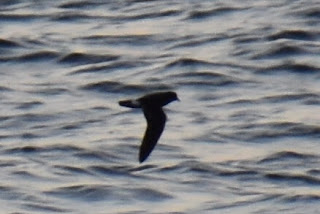Cape May Pelagic, 8/20/23 - White-faced Storm-petrel, 4 Dolphin Species & More
This past weekend I went on my second 24-hour pelagic this summer aboard the American Star out of Cape May, NJ. Last year’s August trip yielded New Jersey’s first record of Bermuda petrel. I missed that voyage, so I signed up for this one soon after it became available. I entertained the thought of seeing my first Bermuda petrel but did not set my hopes high. My more realistic hopes were to see a long-tailed jaeger and/or white-faced storm-petrel. Both of these birds were also seen last August and were missing from my personal State list.
We left the dock at 9 p.m. and made it out to deep water (over 6,000 feet deep), approximately 100 miles offshore, before sunrise. Wilson’s and band-rumped storm-petrels were the first birds to appear in the dawn light. Soon after sunrise a bird was spotted out over the horizon. As it came closer it was apparent it was a jaeger. It never made it close to the boat before it wandered away. Based on its physical appearance and flight style, the consensus of the highly experienced trip leaders was that it was a long-tailed jaeger. I then had scored all three of the jaeger species for New Jersey: parasitic, pomarine and long-tailed.
Band-rumped storm-petrel in the early morning light. © S. Weiss
Band-rumped and Leach’s storm-petrels are longer winged and shorter legged than Wilson’s. They are stronger, more agile flyers than Wilson’s, with different foraging styles.
For a good part of the day, the most common birds we saw were Wilson’s storm-petrels, Cory’s and great shearwaters. Some band-rumped storm-petrels mixed in with the Wilson’s. A single black-capped petrel was spotted in the distance and never approached the boat. A few red-necked phalaropes were seen at times, including one cooperative bird that sat on the water for most to get good views. Late in the morning, we came upon a lone fishing trawler. Pelagic birds like to follow trawlers. They usually find free seafood in the wake of the working boats, which create an unintentional chum slick. This is where we spotted the bulk of our sea birds, many of which sat on the water with full bellies.
Red-necked phalarope. © S. Weiss
Red-necked phalarope is the smallest of the three phalarope species, slightly smaller than a sanderling.
It was here, mixed in with the other storm-petrels, that the crowd favorite was spotted: a white-faced storm-petrel. The lighter colored storm-petrel is rare and irregular here, putting it high on most birders’ wanted lists. They have a very distinct foraging style; kangaroo-like, hopping or bouncing across the water’s surface. This one was very cooperative, staying near the bow of the boat for several minutes, for all to see well. It was a life bird for some, and another state bird for me. I did not get any new life birds for the day, but like all the other participants, was very happy with the storm-petrel.
White-faced storm-petrel. © S. Weiss
The population of white-faced storm-petrels seen off of New Jersey travel across the North Atlantic Ocean from its Cape Verde Islands breeding area, off the northwest coast of Africa. They are broader winged and much longer legged than the darker storm-petrels.
Birds were not the only show out on the ocean. During the day we saw four species of dolphins: Rizzo’s dolphins, striped dolphins, Atlantic spotted dolphins and pelagic bottlenose dolphins. All four species were in separate, large groups, very active and undisturbed by the boat. We did not come across any large whales but did encounter a few groups of pilot whales. Several unidentified species of flying fish soared across the water surface to avoid the moving boat. On the return back towards land, we crossed paths with seven loggerhead sea turtles and one leatherback sea turtle. The striped dolphins, Atlantic spotted dolphins and leatherback sea turtle were new species for me.
Atlantic spotted dolphins. © S. Weiss
Atlantic spotted dolphins start life without spots (lower photo). Their spots appear and become more widespread on the body as the dolphins age.
Striped dolphins. © S. Weiss
The striking and magnificent markings of the striped dolphin set it apart from other species. Common dolphins, equally striking in appearance, instead have an hourglass pattern to their markings. Striped dolphins are very acrobatic and twist their tails as they leap out of the water (lower photo).
Rizzo's dolphin. © S. Weiss
Rizzo's dolphins are noticeably scarred across their bodies and have large, bulbous heads with stubby beaks.
Loggerhead sea turtle. © S. Weiss
One of seven loggerhead sea turtles seen during the day. Loggerheads are smaller than leatherback sea turtles. The loggerhead sea turtle carapace (shell) has box-shaped scutes, whereas the leatherback sea turtle carapace has long, raised ridges.
What make pelagic trips so fun is you never know what you might see out at sea. Surprisingly, two red bats flew near the boat to bring our mammal total to six species.



















Comments
Post a Comment